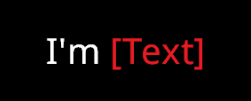Starting from SM5 Preview 1, BitmapText actors can include special instructions to manipulate separate glyphs with things like color. Operations from this use the AddAttribute function to insert these instructions.
-- This adds an attribute to the BitmapText. These are stacked.
self:AddAttribute( [starting point], {[attribute to add]} )
-- This removes all attributes applied on the BitmapText.
self:ClearAttributes()
Any time the BitmapText calls
settextor its own text changes, all attributes assigned to it will be cleared and will need to be reapplied.
¶ The Attributes table
The following are the attributes available via the AddAttribute function.
| Name | Type | Action |
|---|---|---|
| Diffuse | color | Color for the attribute segment. This applies for all the coloring of the glyph. |
| Length | int | How long is the attribute going to be (size is in number of glyphs) |
| Diffuses | table | Table version of the Diffuse attribute, iterates through them all to give different corner colors for the glyph. An example is shown below. |
| Glow | color | Color to apply as additional color for the attribute segment. |
¶ Examples
¶ Squared-Bracketed string conversion
The following example converts a string that includes square brackets into red colored sections.
local function ConvertText( child )
local str = child:GetText()
-- This will contain all possible changes to change the color method.
local charindex = 0
-- Here we'll store the all the possible matches to color.
local ColoringProcess = {}
-- Let's use gmatch to get all matches where a string is enclosed on square brackets.
-- A trick being used here are the empty parenthesis, as gmatch doesn't provide a general index value
-- when there's a proper match found. However, if you include parenthesis before or after a successful match,
-- you'll get the index value of the the start and the end of the match relative to the entire string, which is
-- useful to get the position to apply each attribute.
for p1,m,p2 in str:gmatch("()(%[.-%])()" ) do
ColoringProcess[#ColoringProcess+1] = {
-- The attributes need the value to be 0-indexed, hence the -1, as Lua provides all results starting with 1.
Start = p1-1,
Attr = {
Diffuse = Color.Red,
Length = m:len()
}
}
end
-- We're done. Apply the resulting table's atributes to the text.
for k,v in pairs( ColoringProcess ) do
child:AddAttribute( v.Start, v.Attr )
end
end
return Def.BitmapText{
Font = "Common Normal",
Text = "I'm [Text]",
OnCommand = function(self)
self:Center() -- Center the BitmapText so it's visible
-- Call the function above.
ConvertText(self)
end
}
The result of this example, makes the Text segment of the BitmapText's Text attribute red.

¶ Utilizing the Diffuses attribute
This attribute is a special case, as it requires a table to go through them all, and each will apply to the glyphs corners.
Given this, it has a limit of 4 on the table, any other diffuse in the table past that will be ignored. If there are less than 4 on the table, the rest will be filled with #ffffff.
OnCommand = function(self)
local myColors = {
Color.Red,
Color.Blue,
Color.Blue,
Color.Red,
}
-- Apply the diffuses to all characters in the text.
self:AddAttribute( 0, { Diffuses = myColors, Length = -1 } )
end
The result ends up being that each glyph has red on the top left and bottom right corner, while having blue on the top right and bottom left corners.
